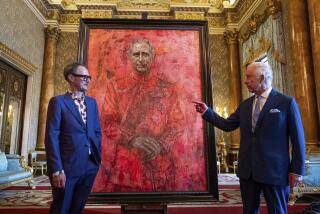‘HELMET’ ATTRIBUTED TO REMBRANDT STUDENT
- Share via
BERLIN — “The Man With the Golden Helmet,” Berlin’s most famous painting and for centuries believed to be a Rembrandt masterpiece, is the work of an unknown artist, an art historian says.
Jan Kelch, a West Berlin-based art historian and specialist on Dutch paintings, said Tuesday that the 20x26 1/2-inch portrait was probably painted in 1650 by one of the Dutch master’s students.
“The painting is not a fake,” Kelch told Associated Press in a telephone interview. “It remains a great masterful work.” Kelch, art historian at the Staatliche Museen Preussischer Kulturbesitz in West Berlin, has been restoring some of West Berlin’s top art works in recent years, including “The Man With the Golden Helmet.”
Kelch said the famous work, probably painted in 1650, has not been on display recently but will be shown in West Berlin’s Kaiser-Friedrich Museum in early 1986.
Doubts about the portrait, painted in typical Rembrandt style contrasting light with dark, emerged when it was removed from the museum group’s gallery for examination and extensive restoration work, expected to be completed early next year.
Kelch said X-rays and other sophisticated tests had revealed that Rembrandt had not painted the portrait himself.
The evocative portrait--the head and shoulders of an elderly man looking broodingly downward, dressed in European light armor with a neck plate and a plumed, golden helmet--is one of the world’s best known and had been a big tourist draw at the West Berlin state gallery.
Doubts about the origin of “The Man With the Golden Helmet” were first voiced last spring by a Dutch curators commission that visited West Berlin.
Questions about the painting’s author also surfaced in July when Reinald Grosshans of the Prussian Institute of Cultural Property said tests indicated the painting’s brushed signature was unlike Rembrandt’s. Grosshans suggested then that an unknown artist was the author.
Some critics have suspected for years that the painting was not a Rembrandt. Some suggested it might be a 19th-Century copy in a style “more Rembrandt than Rembrandt.” Others thought it might be a Rembrandt original tinkered with during a restoration.
The Kaiser-Friedrich Museum association recently published a brochure that listed the painting as the work of an “unknown artist” from the Rembrandt era.
Kelch said important details in the painting did not match Rembrandt’s style on canvas.
“The Man With the Golden Helmet” was painted with very thick layers, almost like a relief work, said Kelch, noting that it was a method that Rembrandt never used.
Kelch said the picture is such a likeness to Rembrandt’s works that it shows the famous Dutch artist was also a “great teacher.”
Rembrandt works are particularly difficult to authenticate. The painter is believed to have signed--or to have allowed his name to be signed--to many paintings from his school but which he actually did not paint. His work is common prey for imitators and forgers.
“Man With a Golden Helmet” was one of more than 700 paintings attributed to Rembrandt, who died penniless and alone in 1669. His most famous work, “Nightwatch,” hangs in the Rijksmuseum in Amsterdam.
Kelch said “Man With a Golden Helmet” would go back on show in West Berlin after its restoration and be in an exhibition explaining how experts had reached their conclusion.
More to Read
The biggest entertainment stories
Get our big stories about Hollywood, film, television, music, arts, culture and more right in your inbox as soon as they publish.
You may occasionally receive promotional content from the Los Angeles Times.










